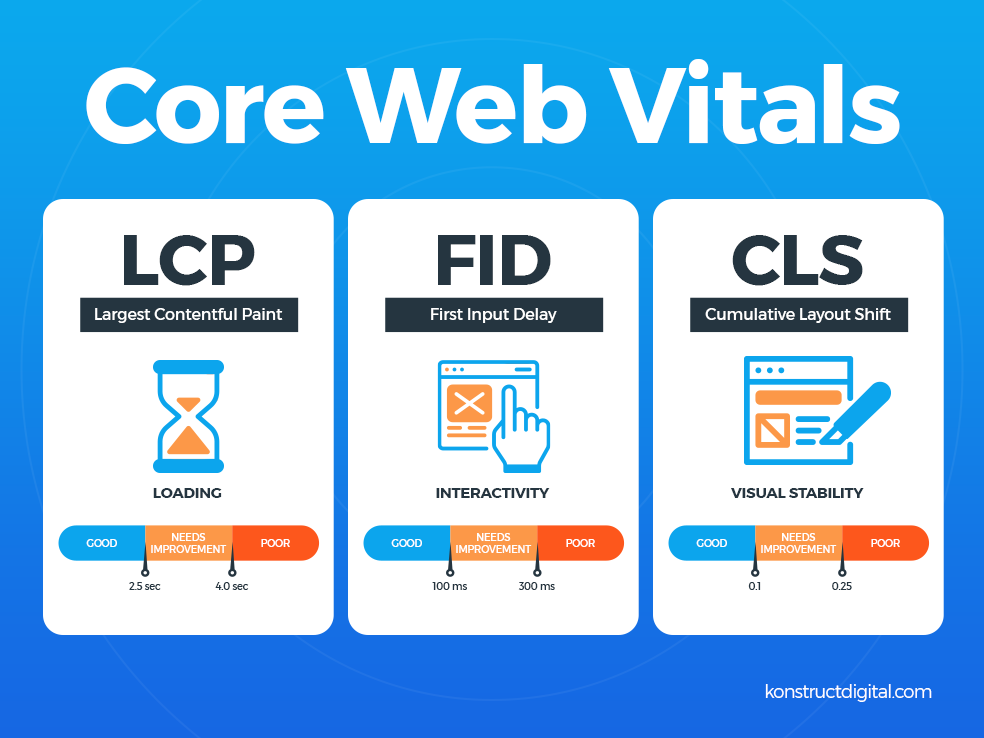The Effect of Core Web Vitals on Search Rankings
In the ever evolving world of SEO, staying ahead of algorithm updates and understanding what affects search rankings is crucial. One of the most significant updates in recent years came from Google, introducing Optimization Core Web Vitals a set of performance metrics that measure the user experience of your website. These metrics focus on load speed, interactivity, and visual stability, which are all key factors that affect how users perceive your website. Let’s explore how Core Web Vitals impact search rankings and how you can improve your website’s performance.
What Are Core Web Vitals?
Core Web Vitals are part of Google’s Page Experience Update, which places emphasis on user experience as a ranking factor. These metrics evaluate the following:
Largest Content-ful Paint (LCP):
Measures loading performance. Specifically, how long it takes for the largest visible content element (like an image or block of text) to load.
First Input Delay (FID):
Measures interactivity. How long it takes for a user to interact with a page (e.g., clicking a button, filling out a form).
Cumulative Layout Shift (CLS):
Measures visual stability. How often do elements shift unexpectedly as the page loads? A low CLS means a stable page where content doesn’t jump around.
Interactive Tip:
To get started, check your site’s performance on Google Page Speed Insights and see how your Core Web Vitals score stacks up. Try improving one metric at a time to see how it affects your overall user experience.
Why Do Core Web Vitals Matter for SEO?
As user experience becomes increasingly important for search rankings, Core Web Vitals provide a direct way for Google to measure how well your site performs in delivering a smooth and enjoyable experience. Websites with better scores for these metrics are likely to see improvements in rankings.
Impact on Search Rankings:
Better User Experience: Sites with fast loading times, quick interaction, and stable layouts lead to higher user satisfaction, which in turn reduces bounce rates.
Higher Engagement: Visitors are more likely to stay on a site that loads quickly and doesn’t have shifting elements, improving key metrics like time on site and pages per session.
Mobile First Optimization: Core Web Vitals are particularly impactful for mobile-first indexing, which is now the default for Google’s search algorithms. Optimizing these metrics will boost your chances of ranking well on mobile searches.
How to Improve Your Core Web Vitals
Improving Core Web Vitals can seem daunting, but breaking it down into manageable steps makes it easier to see improvements. Let’s look at ways you can optimize each of these metrics:
1. Improve LCP (Largest Content-ful Paint)
A fast loading page is essential to providing a positive experience.
What You Can Do:
Optimize Images: Make sure images are compressed and served in next-generation formats such as WebP.
Use Browser Caching: Enable caching to improve load times for returning visitors.
Reduce JavaScript and CSS Blocking: Minimize large scripts and stylesheets that slow down loading.
Use a Content Delivery Network (CDN): Distribute your content across multiple locations to reduce load times for global visitors.
Interactive Tip: Run A/B tests to see how different optimization techniques affect your LCP score.
2. Improve FID (First Input Delay)
A delay in interaction can be frustrating for users. Making sure your site reacts quickly when users click, scroll, or type is crucial.
What You Can Do:
Minimize JavaScript Execution Time: Avoid complex scripts that delay page interactions.
Optimize Your Server Response Times: Faster server responses will reduce the delay between users’ actions and the site’s response.
Use Web Workers for Background Tasks: Offload non-essential tasks to web workers to keep the main thread free for user interaction.
Interactive Tip: Use Google Tag Manager to track FID and experiment with lighter scripts or delayed loading.
3. Improve CLS (Cumulative Layout Shift)
A high CLS score occurs when elements shift unexpectedly while the page loads, leading to a frustrating user experience.
What You Can Do:
Set Size for Images and Ads: Always define width and height for images, ads, and other content to prevent them from shifting as the page loads.
Avoid Unexpected Content Shifts: If you’re using ads, ensure they don’t push content around once loaded.
Preload Important Resources: Preload fonts and key assets to avoid layout shifts caused by late-loading fonts.
Interactive Tip: Use Chrome DevTools to identify and fix layout shifts on your website, ensuring elements load smoothly.
The Key Benefits
Focusing on improving Core Web Vitals isn’t just about ranking higher it’s about creating a better experience for your users, which leads to:
Increased Conversions: Fast, stable websites encourage visitors to take action, such as completing a purchase, subscribing to a newsletter, or exchanging information.
Lower Bounce Rates: Users are less likely to leave a page that loads quickly and provides a smooth browsing experience.
Improved Brand Perception: A website that loads quickly and functions seamlessly creates a positive impression of your brand.
Interactive Tip: Run a Google Lighthouse audit to check your site’s Core Web Vitals and track progress over time.
Core web essentials and the future of SEO
As user experience continues to be a central focus for Google’s algorithms, Core Web Vitals will likely become even more important in the coming years. Search engines will keep prioritizing websites that offer fast, interactive, and stable experiences to users.
Adapting to these changes early will give your website a competitive edge. Plus, it’s not just about SEO improving your website’s performance helps you create a better experience for your customers, which can lead to long-term success.
Conclusion
Optimization Core Web Vitals are now essential for SEO success. They provide an objective way for Google to assess the user experience of your site, and optimizing these metrics can result in better rankings, increased traffic, and higher user satisfaction. Improving LCP, FID, and CLS is within your reach with the right strategies and tools.



